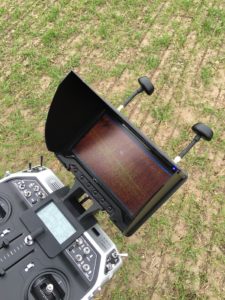Every year in Austria thousands of fawns die an agonising death during mowing. But modern technology means that the search for the young is easier than ever. A drone, equipped with a thermal imaging camera, is the ideal tool for finding the small animals in the tall grass. Both the duration of and the number of people required for the search can thus be drastically reduced.
Fawns, which weigh about 1,200 grams at birth, have the so-called “pressing instinct” for the first three weeks of their life. They press themselves flat on the ground, do not move and hope not to be discovered. Since the fawns are almost odourless they are very hard to discover, even for dogs.

This strategy works very well against predators such as fox, lynx or wild boar. However, it is deadly when the mower approaches. Therefore, hunters and farmers search every field for roe deer fawns before mowing. But this search is not only carried out in the interest of the endangered animals. If the carcass of an animal ends up in a silo after mowing, toxins are formed in the hay and grass silage during decomposition and these can be deadly for cattle and other farm animals. For example, so-called botulism can lead to miscarriages in cattle.
Drones are being increasingly used to make the search easier and more efficient. Very small, commercially available and relatively inexpensive drones, mostly quadcopters, equipped with thermal imaging cameras, are well suited for this purpose. Due to their handiness and easy handling they are an ideal companion for animal rescuers. The search should be carried out before sunrise when the temperature difference between the fawn and its surroundings is the greatest and it is thus easier for the thermal imaging camera to recognise the animals. Later, when the sun is shining on the field, it is difficult to distinguish them from heated objects such as stones or mounds. The drone flies between previously planned waypoints. This automatic flight mode is important because manual control may not ensure that the entire surface is covered, with the right amount of overlapping. In order to be able to process the search quickly, the area plan is transmitted to the drone pilot in advance so that they can create the flight plan. Time is critical in this context, because many farmers in the same region often want to mow at the same time and the search by drone is only useful before sunrise. At least two people must be present during the search: a drone pilot and a hunter or helper who can bring any fawn that is found out of the field. While the quadcopter is flying over the field, possible finding places are marked. It then approaches these places. The helper is equipped with a tablet on which they can see both themself and the fawn as bright spots. This enables them to bring the fawn out of the field.
During a recent deer fawn rescue with the hunt company in Oberhautzental (Lower Austria), numerous hunters were able to make themselves familiar with the technology and experience the deer fawn rescue by drone at first hand. The aim is to expand the service and make it more widely available regionally by next season, starting in spring 2021.
Photo: RWA, Robert Gebauer
